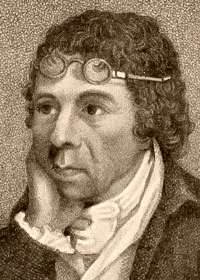James Anderson of Hermiston
.png)
James Anderson FRSE FSA(Scot) (1739 – 15 October 1808)[1] was a Scottish agriculturist, journalist and economist. A member of the Edinburgh Philosophical Society, Anderson was a prominent figure in the Scottish Enlightenment. He invented the Scotch plough.
Early years
Anderson was born at Hermiston, Midlothian and while still young attended lectures on chemistry by William Cullen, at Edinburgh University. At age of 15, after the death of his parents, he took over the working of the family farm.[2]
Economic theorist

In 1777 Anderson published An Enquiry into the Nature of the Corn Laws, in which he anticipated David Ricardo's theory of rent.[2] Some historians believe Anderson was the root source for Marx's critique of capitalist agriculture.
Rent, Anderson argued, was a charge for the use of the more fertile soil. The least fertile soils in cultivation generated an income that simply covered the costs of production, while the more fertile soils received a "certain premium for an exclusive privilege to cultivate them; which will be greater or smaller according to the more or less fertility of the soil. It is this premium which constitutes what we now call rent; a medium by means of which the expence ( [sic]) of cultivating soils of very different degrees of fertility may be reduced to a perfect quality." Anderson argued that improvement of the soil was possible; but also that humans could degrade the soil. He argued also that since where farm land in England was held by capitalists, the farmer would tend to avoid improvements the full return for which would not be received during the lease.
Marx's critique of capitalist agriculture drew upon Anderson's analysis and he insisted that soil fertility was a historical issue, and that fertility could both improve or decline. The irrationality of capitalist agriculture, he argued, was bound up with the whole antagonism of town and country out of which bourgeois society had arisen.[4]
Publisher
In 1783 he settled in Edinburgh. In 1791 he started a weekly publication called The Bee, which was largely written by himself, and of which 18 volumes were published. In 1797 he began to reside at Isleworth, and from 1799 to 1802 he produced a monthly publication, Recreations in Agriculture, Natural History, Arts and Miscellaneous Literature. He was also the author of many pamphlets on agricultural and economical topics, under numerous aliases, including Agricola, Germanicus, and Timothy Hairbrain. One of his first publications was A Practical Treatise on Chimneys (1776). He was a friend of Jeremy Bentham, and involved in the latter's idea of an ideal prison or Panopticon. Anderson also corresponded with George Washington.
Inventor
The engineer James Green, responsible for the building of some of the first canalboat lifts, credited their invention to Dr James Anderson.[5]
The Scotch plough or Scots plough (not to be confused with the Scottish hand plough) was a wood and iron, animal draft, primary tillage implement (plough) for use on heavy ground invented in the 19th century by James Anderson.[6] [7]
Honorarium
In 1780 Anderson received an LLD (honorary doctorate in law) from Aberdeen University. He died in West Ham, Essex on 15 October 1808.[1]
Family
In 1768 Anderson married Margaret Seton (died 1788), and took over the management of Monkshill farm in Aberdeenshire of 1300 acres (5.3 km²). They had 13 children, five boys and one girl surviving their father; one son, John, was apprenticed to Thomas Bewick.[2] The daughter, Margaret (1778–1863), married Benjamin Outram.
References
- 1 2 Waterston, Charles D; Macmillan Shearer, A (July 2006). Former Fellows of the Royal Society of Edinburgh 1783-2002: Biographical Index (PDF). I. Edinburgh: The Royal Society of Edinburgh. ISBN 978-0-902198-84-5. Retrieved 25 November 2011.
- 1 2 3 Mitchinson, Rosalind. "Anderson, James (1739–1808)". Oxford Dictionary of National Biography (online ed.). Oxford University Press. doi:10.1093/ref:odnb/475. (Subscription or UK public library membership required.)
- ↑ http://freemasonry.bcy.ca/biography/anderson_j/anderson_j.html
- ↑ Foster, John Bellamy. (2002) Ecology Against Capitalism, New York: Monthly Review Press
- ↑ The Canals of Southwest England Charles Hadfield Page 104 ISBN 0-7153-8645-X
- ↑ "A History of Agriculture in the Developed World". encyclopedia.jrank.org. 2010. Retrieved April 19, 2012.
- ↑ "Old and New Ploughs". worldburnsclub.com. 2008. Archived from the original on 14 December 2009. Retrieved 19 April 2012.
Further reading

External links
| Wikimedia Commons has media related to James Anderson (agriculturist). |
| Wikisource has original works written by or about: James Anderson |
- Dr. James Anderson (honorary doctorate in law, 1780, Aberdeen), in History of Economic Thought, Scottish Enlightenment, Center for Economic Policy Analysis (CEPA), New School University
- (1777) Observations on the Means of Exciting a Spirit of National Industry
- Attribution
![]()